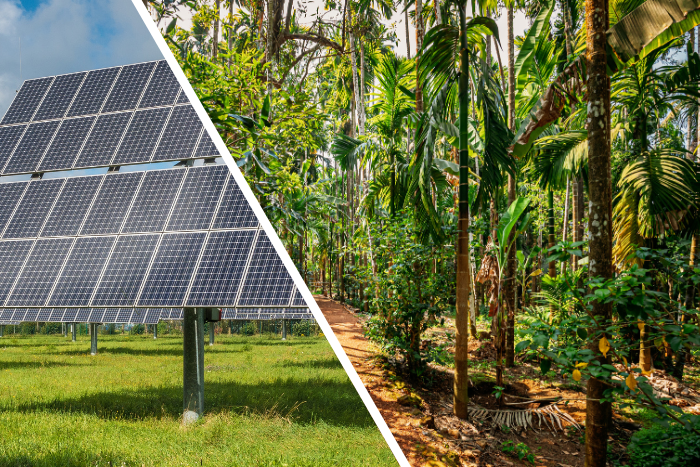India’s 4th Biennial Update Report to UNFCCC embodies information on the country’s national circumstances, mitigation actions, an analysis of the constraints, gaps, related finance, technology, and capacity-building needs
India’s overall greenhouse gas (GHG) emissions dropped by 7.93% in 2020 as compared to 2019. Also, the country’s emission intensity, that is GHGs emitted per unit of GDP, dropped by 36% between 2005-2020, as highlighted in the fourth Biennial Update Report (BUR-4) to the United Nations Framework Convention on Climate Change (UNFCCC).
In the report, India said that the country has progressively continued decoupling economic growth from emissions.
According to the report, India’s forests and tree cover have been growing steadily over time, making them a net sink because of national policies that support sustainable forest management and conservation. The report also discussed various sectors like power, industry, transport, waste, and an analysis of the constraints, gaps, related finance, technology, and capacity-building needs, etc. We present the key highlights from the report below.
Rising forest cover
According to the report, India’s forest and tree cover has consistently increased and currently stands at 25.17% of the total geographical area of the country.
In 2020, India’s forest and tree cover, along with other land use, sequestered approximately 522 million tonnes of CO2, equivalent to reducing 22% of the country’s total carbon dioxide emissions in 2020. During 2005 to 2021, an additional carbon sink of 2.29 billion tonnes of CO2 equivalent has been created, the report added.
India ranks third globally with respect to the net gain in average annual forest area between 2010 and 2020, added the report. Schemes such as the Green India Mission (GIM), Compensatory Afforestation Fund Management and Planning Authority (CAMPA), National Afforestation Programme (NAP), Green Highway Policy—2015, Policy for Enhancement of Urban Greens, National Agro-forestry Policy, and Sub-Mission on Agro-forestry (SMAF) are a few of the important policy interventions of the government.
Another statement by the Indian government had said that the base year for India’s commitment under the Nationally Determined Contributions, to create an additional carbon sink of 2.5 to 3 billion tonnes of CO2 equivalent through additional forest and tree cover by 2030, is 2005. Accordingly, as reported by Forest Survey of India (FSI), Dehradun, India has so far achieved an additional carbon sink of 1.97 billion tonnes of CO2 equivalent.
Energy and industry
With respect to India’s NDC targets, the report said that by October 2024, the share of non-fossil sources in the installed electricity generation capacity in the country stood at 46.52%. Total installed capacity of renewable power, including large hydropower, is 203.22 GW and cumulative renewable power installed capacity (excluding large hydro projects) has increased 4.5 times from 35 GW in March 2014 to 156.25 GW, the report noted.
However, the two major contributors to the total energy supply in the country were coal, which accounted for 57.82% of the total, and crude oil, which accounted for 31.48%. The industrial sector was the largest consumer of energy in the country with this sector itself using 48.95% of the total final energy consumption. Iron and steel were the sector’s most energy-intensive industries, accounting for 15.15% of the industrial energy use, followed by chemicals and petrochemicals, 4.56 %, and construction, 1.80%.
The consumption of the residential, agriculture, commercial, and public sectors and non-energy purposes represented 39.34% of the total final consumption in the country. In contrast, the transport sector accounted for 11.70% of the total final consumption.
On a positive note, the report found a significant increase in the emphasis on energy efficiency within the industrial sector through initiatives like the Perform, Achieve, and Trade (PAT) scheme over the last few years.
Climate and agriculture
Indian agriculture remains vulnerable to weather vagaries despite self-sufficiency in food grain production. Farmers have additional difficulties as a result of climate change, an increase in extreme weather occurrences in recent decades, and uncertainty surrounding their forecasts, which has led to significant losses in agricultural productivity. Heat waves and floods have seriously harmed crop production and harvesting operations in the country.
According to the report, state-by-state reports on observed rainfall trends and variability based on recent 30-year data (1989-2018) showed that the frequency of heavy rainfall events in various regions of the nation was significantly increasing, as was the number of dry days during the monsoon.
Despite the above factors, the report said, there has been a consistent increase in the production of both food grains and horticultural products in India. This indicated the importance of developing climate-resilient crop varieties, appropriate farming systems, social security and welfare measures, and other interventions.
Need for technology transfer
The report stated that despite significant national efforts and investments, obstacles such as intellectual property rights (IPR) and sluggish international knowledge transfer prevent these technologies from being adopted quickly. India said in the report that affluent nations have continuously failed to fulfil their duties, commitments, and duties under the UNFCCC and its Paris Agreement to provide climate funding to developing nations. The country seeks climate specific grants and/or concessional loans, predominantly from public sources of funding, with appropriate balance between mitigation and adaptation and based on India’s articulation of its needs and development aspirations.
This lack of technology transfer has led India to rely heavily on domestic resources and stretch national capacity, consequently slowing its efforts to achieve critical climate objectives, said the report.
About The Author
You may also like
India says it won’t rely on global climate or pollution rankings to shape policies
COP30 Kicks Off With Hard Talks on Money, Adaptation and Global South Leadership
COP30 should be the COP of adaptation, says environment minister Bhupendra Yadav
India to release updated climate plan ‘during, or just ahead’ of Brazil COP in Nov
SCO summit concludes: ‘Energy diplomacy’ of China, Russia, India

